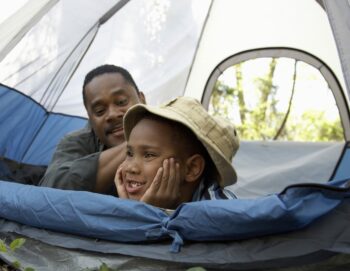
With temperatures on the rise, many families have begun planning for some fun, outdoor adventures.
If camping is on the agenda, it’s important to be informed and prepared before heading off to any campgrounds, especially when camping with small children.
Dr. Michelle Terry, a pediatrician at Seattle Children’s, shares some key advice and tips with On the Pulse on what parents and caregivers should know to ensure kids and the whole family are healthy and safe while camping.
Take time to make a plan
From setting up tents, to exploring nature, to roasting marshmallows by the fire – there is a lot of fun to be had outdoors, but a poorly planned camping trip can quickly turn into a nightmare.
“Prepare for the trip by reading books about camping and perhaps even setting up the ‘campsite’ in a child’s room before you go,” said Dr. Terry. “Plan to stick to mealtime and bedtime routines as much as possible while enjoying the outdoors.”
Plan ahead to create an experience that is fun and accessible for everyone. A campground should fit with a family’s comfort level and have elements that meet the needs of the group.
“Camping in a familiar area with quick access to extra supplies can take some of the stress out of your trip,” explained Dr. Terry. “Double check your camp reservations so that you are familiar with the arrival and departure times, as well as the amenities available at the campsite.”
Be sure to also plan for all types of weather, especially if visiting areas where conditions can change quickly.
“Families should prepare for temperatures ranging from the 40s to the 80s, and of course prepare for rain,” added Dr. Terry.
Proper packing is key
For a safe and fun camping trip, be sure to bring along the essentials. Though each camping excursion’s packing list may vary depending on the individual setting, difficulty and length, it’s important to bring along equipment and supplies that will keep everyone safe and comfortable.
“School-aged children should be responsible for packing their own gear at home,” said Dr. Terry. “Just be sure to double check your child’s bag before heading out.”
Shelter and bedding should include a base layer, sleeping bags and extra blankets. Tents, a ground cloth, or a tarp can ensure that kids stay protected from the sun and insects, even on short adventures.
Clothing should be lightweight, light-colored and long-sleeved. Layering and an extra set of clothing can help if there is unexpected rain or wind. Wide-brimmed hats, sunglasses, insect repellant and sunscreen should also be packed.
Families should also pack extra water and food. It’s best to stick with healthy on-the-go snacks and sugar-free drinks for the kids. Other items to bring along include things like a first-aid kit, sanitizer and other toiletries, protective gear including life jackets and helmets, a compass or GPS, and flashlights with extra batteries.
“Consider packing kid-size camp chairs and other supplies that small hands can handle,” added Dr. Terry. “Make sure that kids have their own flashlight, headlamp or other camp lighting. A string of battery-powered lights to hang in the tent or camper van may also help them adjust to being without access to the glow from nightlights or streetlights.”
Precaution: Safety tips for the campsite
Camping comes with hazards including wildlife, insects, fires, food-related illness and environmental concerns. To help prevent injury, be aware of all surroundings when camping.
“Teach kid to respect the environment by ‘leaving no trace’ of their presence and show them how to dispose of waste properly,” suggested Dr. Terry.
The National Park Service (NPS) also recommends checking in with a park ranger or campsite host regarding any park alerts or conditions, such as wildlife sightings in the area, severe weather such as flash flooding or lightning, dead trees, rock falls, air quality and more.
When camping with small children, caregivers should inspect their campsite to ensure there is no glass or garbage, matches, knives or sharp rocks in the area.
“Debris can easily make its way into a child’s curious hands or mouth,” said Dr. Terry. “Be on the constant look out for potential choking hazards – babies older than three months like to put things in their mouths.”
Keep medicines, repellents, roasting sticks or other dangerous tools out of reach of children and be alert for plants that could cause skin irritation or a harmful reaction.
“Parents and caregivers should give kids an overview of potential plant irritants like poison ivy or poison oak,” explained Dr. Terry. “In general, they should avoid touching plants.”
Children should always be supervised, especially in the wilderness where there are steep hills, rocks, streams and lakes.
“Consider bringing a portable play pen, a standing seat, or a back carrier,” added Dr. Terry. “Set up the play area away from the fire pit, open water and the cooking area. Additionally, no one should ever leave a camp fire unattended. Children should always be watched closely around fire, and adults should make sure it is extinguished before everyone turns in for the night.”
Camping can be a great way to bond with the family, just remember to consider the three 3 P’s – planning, preparation and precaution, to ensure everyone has a positive and safe experience.

